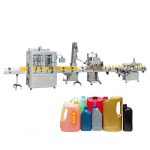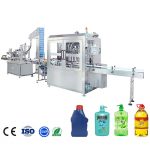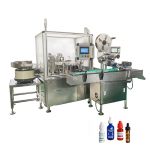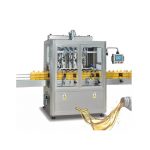A salsa filling machine is a device used to fill containers with salsa, a type of sauce made from a mixture of diced tomatoes, onions, peppers, and other ingredients. These machines are commonly used in the food processing industry to package salsa for distribution and sale. In this ultimate guide, we will cover everything you need to know about salsa filling machines, including how they work, the different types available, and how to choose the right one for your business.

How Salsa Filling Machines Work
Salsa filling machines typically operate using a piston or volumetric filling system. In a piston filling system, a motor-driven piston moves up and down inside a cylinder, drawing salsa from a hopper and filling the container as the piston moves downward. This type of filling machine is highly accurate and can fill containers with precise volumes of salsa.
Volumetric filling machines, on the other hand, use a set of measuring cups or tubes to dispense a specific volume of salsa into the container. These machines are also accurate and can fill containers with precise volumes of salsa, but they are typically slower than piston filling machines.
Types of Salsa Filling Machines
There are several different types of salsa filling machines available on the market, each designed for specific production needs and budgets. Some common types of salsa filling machines include:
- Semi-automatic filling machines: These machines are manually operated and require an operator to place the containers under the filling nozzle and start the filling process. Semi-automatic filling machines are typically the most affordable option and are well-suited for small- to medium-sized operations.
- Automatic filling machines: These machines are fully automated and do not require an operator to start the filling process. Instead, the containers are conveyed to the filling station automatically, and the machine fills them and moves them to the next stage of the packaging process. Automatic filling machines are more expensive than semi-automatic filling machines but are much faster and more efficient.
- Inline filling machines: These machines are designed to be integrated into a production line and are often used in high-speed, high-volume operations. Inline filling machines can fill hundreds or even thousands of containers per hour and are typically the most expensive type of salsa filling machine.
Choosing the Right Salsa Filling Machine
When choosing a salsa filling machine, there are several factors to consider, including production volume, container size and shape, and budget. Here are some tips to help you choose the right salsa filling machine for your business:
- Determine your production volume: The first step in choosing a salsa filling machine is to determine your production volume. This will help you determine the size and type of machine you need. If you have a small- to medium-sized operation, a semi-automatic filling machine may be sufficient. For larger operations, you may need an automatic or inline filling machine.
- Consider container size and shape: Salsa filling machines are designed to fill specific types and sizes of containers. Be sure to choose a machine that is capable of filling the containers you plan to use. You should also consider the shape of the containers, as some machines may be better suited for filling certain shapes.
- Determine your budget: Salsa filling machines can range in price from a few thousand dollars for a semi-automatic filling machine to hundreds of thousands of dollars for an automatic or inline filling machine. Determine your budget and choose a machine that fits your needs and price range. It may be tempting to go for the cheapest option, but keep in mind that purchasing a cheaper, lower-quality machine could result in costly repairs and downtime in the long run.
- Think about the filling process: Consider the filling process and the type of salsa you will be filling. If you are filling thin, watery salsa, a piston filling machine may be the best choice. If you are filling thicker salsa, a volumetric filling machine may be more suitable.
- Consider additional features: Some salsa filling machines come with additional features, such as capping and labeling stations, that can help streamline the packaging process. If you plan to package your salsa in bottles or jars with caps, you may want to consider a filling machine that includes a capping station. If you plan to label your containers, you may want to choose a machine that includes a labeling station.
- Evaluate the after-sales service: It is important to choose a salsa filling machine from a reputable manufacturer that offers good after-sales service. This includes technical support, maintenance and repair services, and spare parts availability.
Maintaining Your Salsa Filling Machine
Proper maintenance is key to keeping your salsa filling machine running smoothly and efficiently. Here are some tips for maintaining your salsa filling machine:
- Follow the manufacturer's recommendations: Be sure to follow the manufacturer's recommendations for maintaining your salsa filling machine. This may include regular cleaning and lubrication, as well as replacing wear parts and filters.
- Clean the machine regularly: Salsa filling machines should be cleaned regularly to prevent contamination and ensure accurate filling. Follow the manufacturer's instructions for cleaning the machine, and be sure to clean all surfaces, including the filling nozzle, hopper, and conveyor belt.
- Lubricate moving parts: Regular lubrication of moving parts is important to keep your salsa filling machine running smoothly. Follow the manufacturer's recommendations for lubrication, and be sure to use the correct type of lubricant.
- Replace wear parts: Wear parts, such as seals and gaskets, will eventually need to be replaced. Follow the manufacturer's recommendations for replacing these parts to ensure the proper operation of your salsa filling machine.
- Keep spare parts on hand: It's a good idea to keep a stock of spare parts on hand, such as seals, gaskets, and filters, in case of unexpected breakdowns or repairs. This will help you minimize downtime and keep your salsa filling machine running smoothly.
Conclusion
A salsa filling machine is a valuable asset for any food processing operation that produces and packages salsa for distribution and sale. These machines can save time and labor, and help ensure accurate and consistent filling of containers. By considering factors such as production volume, container size and shape, budget, and additional features, you can choose the right salsa filling machine for your business. Proper maintenance is also crucial to keep your machine running smoothly and efficiently.










